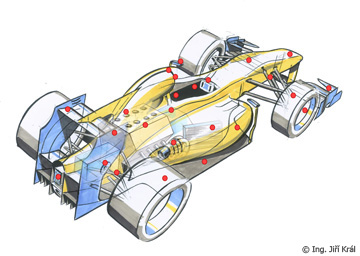Formula 1 Canadian GP: quite possibly the toughest race for the Brembo brakes
Alessandra Fedeli/ Brembo | 8.6.17 | Brembo F1 brzdy
Brembo F1 2017
The most challenging test bench for the Brembo braking systems on single-seaters explained braking point by braking point
From June 9 to 11, Circuit Gilles-Villeneuve will host the 7th race of the 2017 World Formula 1 Championship. Named for the legendary Ferrari driver, this circuit is celebrating the 50th anniversary of its first Formula 1 Canadian GP. The first ten editions were held however at Mosport Park (8) and Mont-Tremblant (2). The track is located on the Isle of Notre Dame, an artificial island built in 1965 on the Saint Lawrence River as the Montreal underground was being constructed.
Characterized by alternating straightaways, chicanes and hairpin turns, this track is without a doubt the toughest test bench for the braking systems on the single-seaters, which usually show up here with a low aerodynamic load. The braking points, all hard and very close together, cause soaring operating temperatures of the discs and pads, which don't have enough time to cool down on the straight stretches.
Grip increases as rubber is laid on the track, and, as we expect the single-seaters to experience in 2017, this will lead the braking torque to be higher compared to the 2016 season. To deal with the changes adopted this season, Brembo has increased the thickness of the carbon discs from 28 mm to 32 mm, and has added holes to cool them, taking the total from 1,200 to 1,400.
Another problem for the braking systems is the tailwind on the two main straightaways: when it pushes from behind, the straight line speed is increased, putting the brakes to an even more rigorous test.
According to Brembo technicians, who classified the 20 tracks in the World Championship on a scale of 1 to 10, Circuit Gilles-Villeneuve falls into the category of highly demanding circuits for the brakes. The Canadian track earned a 10 on the difficulty index, which is the same score given to the tracks in Abu Dhabi, Mexico City and Singapore.
The demand on the brakes during the GP
As demonstrated by the Monaco GP, the number of braking points is not indicative of how hard the brakes have to work. At Circuit Gilles-Villeneuve, the drivers turn to their brakes only seven times per lap, compared to nine times in Melbourne, ten in Sochi and twelve in Monaco.
In Canada, the brakes are used for 11.7 seconds every lap, which is equivalent to 17% of the overall duration of the race. The time spent braking may not be exceptional, but six points on the track are because their peak deceleration reaches at least 4.5 G and the load applied to the pedal surpasses 150 kg. These figures contribute to the average peak deceleration hitting 4.4 G.
The energy dissipated in braking by each race car during the entire GP is 179 kWh, the same amount as the hourly energy consumption of 62 families in Quebec.
From the starting line to the checkered flag, the Brembo technicians forecast that each driver will exert a total force on the pedal of approximately 72 tons, which is the same as the total weight of 130 Canadian moose.
The most demanding braking sections
Of the seven braking sections on Circuit Gilles-Villeneuve, a good four are considered very demanding on the brakes, two are of medium difficulty and one is light.
The most critical is the last, the chicane that precedes the famous "Wall of Champions" where control going into the turn is essential to avoid launching the car over the kerb. On this corner, an exceptional feeling with the brakes can make the difference between a good lap time and a crash. The single-seaters arrive going 322 km/h and brake for 1.6 seconds to reduce their speed to 148 km/h. They manage to do this in 49 meters, which is about 10 meters shorter than the length of an ice hockey rink. The drivers are required to apply a remarkable amount of force: 161 kg are applied to the brake pedal and the deceleration measures 4.7 G.
Braking on turn 8 is also very difficult because the speeds drop from 297 km/h to 130 km/h in just 47 meters and 1.62 seconds. The load on the pedal measures 160 kg and the deceleration reaches 4.8 G, a figure that surpasses what the first astronauts will experience when they land on Mars.
In terms of braking distance, turn 10 is beyond comparison. Drivers often use this corner for overtaking: the single-seaters have 63 meters to go from 292 km/h to 68km/h in just 2.44 seconds.
Brembo performance
Single-seaters with Brembo brakes have won 19 of the 39 Canadian GP races they have participated in, including the last four. The last driver to win three GP races in a row with Brembo calipers was Michael Schumacher with Ferrari, from 2002 to 2004. This is a result that Lewis Hamilton could repeat, having been victorious at the last two editions. Ferrari on the other hand hasn't won in Montreal since 2004.




